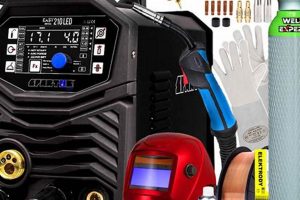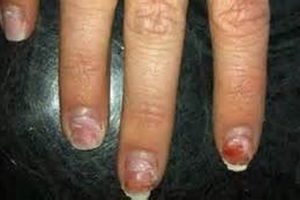Manual metal arc welding, often referred to by its acronym, involves the use of a consumable electrode coated in flux to create an electric arc between the electrode and the base metal. The parameters governing this process, encompassing amperage, voltage, electrode type, and travel speed, are crucial for achieving a high-quality weld. For instance, a welder working on thin sheet metal might employ a lower amperage and smaller diameter electrode than someone welding thick steel plates.
Proper parameter selection directly influences weld integrity, affecting factors such as penetration, bead profile, and overall strength. Historically, welders relied heavily on experience and visual inspection to determine optimal parameters. However, advancements in welding technology have led to more precise control and understanding of these critical variables, significantly enhancing weld quality and consistency while minimizing defects. This improved control also contributes to increased efficiency and reduced material waste.
This article will explore the various parameters involved in the process in detail, including the influence of electrode selection, the relationship between amperage and voltage, and the impact of travel speed on weld bead characteristics. Furthermore, the discussion will cover techniques for optimizing these variables for different materials and thicknesses, ultimately aiming to improve welding proficiency and produce stronger, more reliable welds.
Tips for Optimal Manual Metal Arc Welding Parameters
Achieving successful welds requires careful consideration of several key parameters. The following tips offer guidance for optimizing the welding process.
Tip 1: Electrode Selection: Choosing the correct electrode is paramount. The electrode’s composition must be compatible with the base metal being welded to ensure proper fusion and prevent defects. Consult electrode specifications and material data sheets for proper selection.
Tip 2: Amperage Control: Amperage significantly influences weld penetration and bead profile. Too low an amperage can result in poor fusion and a weak weld, while excessive amperage can cause burn-through, especially in thinner materials. Reference recommended amperage ranges provided by electrode manufacturers.
Tip 3: Voltage Considerations: Voltage affects arc length and stability. Maintaining a consistent arc length is crucial for a uniform weld bead. Adjust voltage based on the electrode type and desired arc characteristics.
Tip 4: Travel Speed: Travel speed dictates the amount of heat input and the size of the weld bead. Moving too slowly can lead to excessive heat input and potential warping, while moving too quickly can result in insufficient fusion. Practice maintaining a consistent travel speed that produces a desirable bead profile.
Tip 5: Work Angle: The angle at which the electrode is held relative to the joint impacts the weld bead shape and penetration. Experimenting with different work angles can help achieve the desired weld profile.
Tip 6: Preheating and Interpass Temperature: For certain materials, preheating and controlling the interpass temperature are crucial to prevent cracking, especially in thicker sections or materials prone to hydrogen cracking. Consult relevant welding procedures for specific preheat and interpass temperature requirements.
Tip 7: Cleaning and Preparation: Ensuring the base metal is clean and free of contaminants such as rust, oil, or paint is essential for achieving a sound weld. Proper joint preparation, including beveling or grinding, may also be necessary depending on the joint design and material thickness.
By adhering to these guidelines, welders can achieve superior weld quality, minimize defects, and enhance overall welding efficiency. Consistent application of these principles will lead to stronger, more reliable welds across various applications.
This discussion now transitions to a concluding summary of the key takeaways for optimizing manual metal arc welding parameters.
1. Amperage
Amperage stands as a fundamental parameter within manual metal arc welding settings, directly influencing the heat generated within the welding arc. This heat input governs weld penetration, bead profile, and the overall quality of the weld. Understanding the role of amperage is crucial for achieving optimal welding results.
- Penetration Control
Amperage primarily dictates the depth of weld penetration. Higher amperage settings generate greater heat, leading to deeper penetration into the base material. This is essential for welding thicker materials where a strong, full-penetration weld is required. Conversely, lower amperage is necessary for thinner materials to prevent burn-through.
- Bead Profile Influence
Amperage also affects the shape and appearance of the weld bead. Lower amperage typically produces a narrower, more convex bead, while higher amperage results in a wider, flatter bead. The desired bead profile depends on the specific application and joint design. For instance, a flat bead might be preferred for fillet welds, while a convex bead might be suitable for butt welds.
- Electrode Selection Interplay
Amperage settings are intrinsically linked to electrode selection. Each electrode type has a recommended amperage range specified by the manufacturer. Using an amperage outside this range can lead to poor arc stability, excessive spatter, or inadequate weld quality. The electrode diameter also influences the appropriate amperage range, with larger diameter electrodes requiring higher amperage.
- Material Thickness Considerations
Material thickness plays a significant role in determining the appropriate amperage. Thicker materials necessitate higher amperage to achieve sufficient penetration, while thinner materials require lower amperage to avoid burn-through. Welders must carefully select the correct amperage based on the material thickness to ensure a sound weld.
Proper amperage selection, in conjunction with other parameters such as voltage, travel speed, and electrode type, is paramount for achieving high-quality manual metal arc welds. A comprehensive understanding of the interplay between these settings empowers welders to optimize their processes and produce strong, reliable welds across diverse applications. Ignoring the critical role of amperage can compromise weld integrity and lead to structural weaknesses.
2. Voltage
Voltage plays a crucial role in manual metal arc welding (MMA) settings, influencing arc length, stability, and ultimately, weld quality. It represents the electrical potential difference between the electrode and the workpiece, directly affecting the energy transferred across the arc. This energy transfer influences the melting rate of the electrode and the base metal, impacting both the weld bead profile and penetration.
The relationship between voltage and arc length is particularly significant. Higher voltage settings result in a longer arc length, while lower voltage settings produce a shorter arc length. A longer arc, though offering greater reach into complex joints, can become unstable and lead to increased spatter and porosity within the weld. Conversely, a shorter arc provides better control and stability, contributing to a cleaner, more consistent weld bead. For example, welding in a confined space or on a complex joint might necessitate a slightly higher voltage to maintain arc stability despite the restricted access. However, excessive voltage can compromise weld quality due to arc instability and increased spatter. In contrast, welding on flat, open surfaces generally benefits from lower voltage settings, promoting a stable arc and a smooth weld bead.
Understanding the impact of voltage on arc characteristics is fundamental for achieving optimal welding results. Selecting the correct voltage for a given application requires considering factors such as electrode type, material thickness, and joint configuration. Incorrect voltage settings can lead to a range of welding defects, including porosity, incomplete fusion, and excessive spatter. Welders must therefore possess a comprehensive understanding of the relationship between voltage, arc length, and weld quality to produce strong, reliable welds consistently. This understanding enables appropriate voltage adjustments based on specific welding situations, contributing to improved weld integrity and overall project success.
3. Electrode Type
Electrode selection stands as a critical aspect of manual metal arc welding (MMA) settings, directly influencing weld quality, mechanical properties, and overall project success. Choosing the appropriate electrode hinges on understanding the base material’s composition, the desired weld characteristics, and the surrounding environmental conditions. Different electrode types exhibit varying properties, making careful selection paramount for achieving optimal welding outcomes.
- Material Compatibility
Electrode composition must be compatible with the base material being welded. Using an incompatible electrode can lead to a weak weld, cracking, or other defects. For instance, welding mild steel typically requires a low-hydrogen electrode to minimize the risk of hydrogen-induced cracking. Stainless steel, on the other hand, necessitates an electrode specifically designed for stainless steel to maintain corrosion resistance and prevent weld decay. Aluminum welding often employs electrodes with specific alloying elements to ensure proper fusion and prevent oxide formation.
- Mechanical Properties
Different electrodes impart varying mechanical properties to the weld. Some electrodes are designed for high-strength applications, while others prioritize ductility or toughness. For example, certain electrodes produce welds with high tensile strength, suitable for structural applications, while others prioritize impact resistance, essential for components subjected to dynamic loads. The selection must align with the intended service conditions of the welded component.
- Operating Characteristics
Electrodes exhibit distinct operating characteristics, influencing arc stability, slag removal, and bead appearance. Some electrodes offer smooth arc characteristics and easy slag removal, simplifying the welding process and improving efficiency. Others might produce a specific bead profile or penetration characteristic, beneficial for particular welding scenarios. The ease of slag removal, for instance, can significantly impact productivity, especially in multi-pass welding operations.
- Environmental Considerations
Environmental factors, such as humidity and temperature, can influence electrode selection. Low-hydrogen electrodes, for example, are susceptible to moisture absorption, requiring proper storage and handling to prevent weld defects. In some cases, specialized electrodes designed for low-temperature applications might be necessary to ensure adequate weld quality in cold environments. Proper consideration of environmental conditions safeguards against potential welding issues arising from inappropriate electrode storage or usage.
In summary, selecting the correct electrode is an integral part of optimizing MMA welding settings. Careful consideration of material compatibility, desired mechanical properties, operating characteristics, and environmental factors ensures weld integrity, enhances performance, and contributes to the overall success of the welding project. Neglecting the critical role of electrode selection can compromise weld quality and lead to costly rework or even structural failure.
4. Travel Speed
Travel speed, a critical component of manual metal arc welding (MMA) settings, significantly influences weld bead characteristics, heat input, and overall weld quality. Defined as the rate at which the electrode progresses along the weld joint, travel speed directly impacts the amount of heat energy transferred to the base material. This intricate relationship between travel speed and heat input necessitates careful control to achieve desired weld properties. Manipulating travel speed effectively allows welders to fine-tune heat input, ensuring optimal weld penetration and bead profile.
Slower travel speeds increase heat input, resulting in wider, flatter beads with deeper penetration. This proves beneficial for welding thicker materials requiring substantial fusion. For instance, welding thick steel plates for structural applications often necessitates slower travel speeds to ensure full penetration and a strong weld. Conversely, faster travel speeds reduce heat input, yielding narrower, more convex beads with shallower penetration. This approach suits thinner materials where excessive heat input could lead to burn-through or distortion. Welding sheet metal for automotive bodywork, for example, typically requires faster travel speeds to minimize heat-affected zones and prevent warping. Maintaining consistent travel speed throughout the weld is crucial for achieving uniform bead characteristics and preventing inconsistencies in weld quality.
Balancing travel speed with other MMA parameters, such as amperage and voltage, is essential for optimizing weld properties. An improper travel speed, even with correct amperage and voltage settings, can compromise weld integrity. Excessive travel speed can result in insufficient fusion and a weak weld, while excessively slow travel speed can lead to excessive heat input, causing warping, distortion, and potential burn-through. Mastering travel speed control enables welders to achieve consistent, high-quality welds across diverse applications and material thicknesses. This control forms a cornerstone of proficient MMA welding, contributing significantly to structural integrity and long-term performance of welded components.
5. Preheating
Preheating, an integral component of manual metal arc welding (MMA) settings, plays a crucial role in mitigating risks associated with rapid cooling rates in certain materials. Specifically, preheating involves raising the base metal’s temperature before welding, slowing the cooling rate of the weld and the surrounding heat-affected zone (HAZ). This controlled cooling minimizes the risk of hardening, cracking, and residual stress buildup, particularly in high-carbon steels, alloy steels, and thick sections. Preheating temperatures vary depending on the specific material and its susceptibility to these issues, often requiring consultation of welding codes and material specifications. For example, welding high-carbon steel might require preheating to several hundred degrees Celsius to prevent the formation of brittle martensite in the HAZ, which could lead to cracking. In contrast, low-carbon steel typically requires minimal or no preheating due to its lower susceptibility to hardening.
The benefits of preheating extend beyond crack prevention. By slowing the cooling rate, preheating reduces the temperature gradient between the weld and the base metal, minimizing residual stresses that could compromise structural integrity. This proves particularly crucial in welded structures subjected to high stress or dynamic loads, where residual stresses could initiate fatigue cracking or other failures. Preheating also improves weld fusion and bead profile by allowing greater heat penetration and reducing the viscosity of the molten metal. This enhanced fusion improves the overall strength and quality of the weld. For example, in pipeline welding, preheating not only mitigates cracking but also improves the weld’s resistance to hydrogen-induced cracking, a common issue in high-pressure environments. In thick section welding, preheating reduces the risk of distortion and warping, which can occur due to uneven cooling and contraction of the weld metal.
In conclusion, preheating serves as a critical control measure within MMA welding settings, directly impacting weld quality, mechanical properties, and structural integrity. Proper application of preheating, informed by material characteristics and welding codes, minimizes the risk of cracking, reduces residual stresses, and improves weld fusion. Neglecting preheating in susceptible materials can compromise weld performance and lead to premature failure. Understanding the relationship between preheating, material properties, and welding parameters is essential for ensuring the long-term reliability and safety of welded structures.
6. Work Angle
Work angle, a key element within manual metal arc welding (MMA) settings, significantly influences weld bead profile, penetration, and overall weld quality. Defined as the angle between the electrode and the workpiece, the work angle encompasses two primary components: the travel angle and the transverse angle. Precise control over these angles is essential for achieving desired weld characteristics and ensuring sound weld integrity.
- Travel Angle
The travel angle, measured in the direction of welding progression, dictates the distribution of heat and molten metal within the weld joint. A steeper travel angle focuses the arc’s energy towards the leading edge of the weld pool, promoting deeper penetration and a narrower bead. Conversely, a shallower travel angle distributes heat more evenly, resulting in a wider bead and shallower penetration. For example, a steeper travel angle is often employed for welding thicker materials requiring full penetration, while a shallower angle is preferred for thin materials to prevent burn-through. Choosing the correct travel angle requires careful consideration of material thickness, joint configuration, and desired weld characteristics.
- Transverse Angle
The transverse angle, measured perpendicular to the direction of travel, influences the weld bead’s width and the wetting action of the molten metal along the joint sides. A larger transverse angle promotes wider bead coverage and improved sidewall fusion, critical for fillet welds and achieving proper joint filling. A smaller transverse angle results in a narrower bead and less sidewall fusion, suitable for butt welds or situations requiring minimal heat input to the surrounding base metal. Controlling the transverse angle ensures proper joint filling, minimizes undercutting, and contributes to a smoother, more aesthetically pleasing weld bead.
- Combined Angle Effects
The travel angle and transverse angle work in conjunction to shape the weld bead and control penetration. Manipulating both angles simultaneously allows welders to fine-tune weld characteristics and achieve optimal results for specific applications. For example, a combination of a steep travel angle and a large transverse angle maximizes penetration and sidewall fusion, ideal for demanding structural welds. Conversely, a shallow travel angle combined with a small transverse angle minimizes heat input and distortion, suitable for welding thin or heat-sensitive materials. Understanding the interplay between these angles is fundamental for achieving precise control over weld bead geometry and penetration.
- Positional Welding Implications
Work angle adjustments become even more critical in positional welding, where gravity influences the molten weld pool’s behavior. Maintaining proper work angles in vertical, overhead, or horizontal positions requires adapting techniques to counteract gravity’s effects and ensure consistent weld quality. For instance, in vertical-up welding, a slightly steeper travel angle might be necessary to control the molten metal and prevent it from sagging. In overhead welding, a shallower travel angle helps retain the molten weld pool against gravity. Mastering work angle adjustments in various positions is essential for producing sound welds across diverse applications.
In summary, work angle manipulation within MMA welding settings is a critical skill directly impacting weld bead profile, penetration, and overall weld quality. Understanding the interplay between travel angle, transverse angle, and positional considerations enables welders to optimize welding parameters and achieve desired results across a wide range of applications. Proficient control over work angles contributes significantly to weld integrity, structural performance, and the long-term reliability of welded components.
7. Duty Cycle
Duty cycle represents a critical constraint within manual metal arc welding (MMA) settings, directly impacting equipment longevity and operational efficiency. Defined as the percentage of time a welding machine can operate at a specific amperage within a ten-minute period without overheating, duty cycle limitations necessitate careful consideration during welding procedures. Exceeding the duty cycle can lead to thermal overload, potentially damaging internal components and shortening the machine’s lifespan. For instance, a 60% duty cycle at 200 amps signifies the machine can weld continuously at that amperage for six minutes within a ten-minute interval. The remaining four minutes require rest to allow the machine to cool down and prevent overheating. Ignoring this limitation risks thermal damage and premature equipment failure. Conversely, operating at lower amperages often allows for a higher duty cycle, permitting longer welding durations without interruption.
Understanding the relationship between duty cycle and amperage is essential for optimizing welding operations. Higher amperages, while facilitating faster welding speeds and deeper penetration, generally come with lower duty cycle ratings. This necessitates planned rest periods to avoid exceeding the machine’s thermal capacity. For example, welding thick sections requiring high amperage might involve shorter welding bursts interspersed with cooling periods. Conversely, welding thinner materials at lower amperages allows for longer continuous operation due to the higher duty cycle. In production environments, incorporating duty cycle considerations into welding procedures ensures efficient workflow management and minimizes downtime associated with equipment overheating. Selecting welding machines with appropriate duty cycle ratings for the intended application is crucial for maximizing productivity and minimizing equipment wear.
In summary, duty cycle considerations play a significant role in optimizing MMA welding settings. Balancing amperage requirements with duty cycle limitations ensures efficient operation, prevents equipment damage, and contributes to the overall cost-effectiveness of welding processes. Ignoring duty cycle constraints can lead to thermal overload, decreased equipment lifespan, and ultimately, increased operational costs. A comprehensive understanding of duty cycle and its practical implications empowers welders to make informed decisions regarding equipment selection and operational parameters, maximizing productivity while safeguarding valuable welding assets. This understanding forms an integral part of proficient MMA welding practice, ensuring both efficient project completion and long-term equipment reliability.
Frequently Asked Questions about MMA Welding Settings
This section addresses common inquiries regarding parameters crucial for successful manual metal arc welding. Understanding these aspects helps ensure weld quality and operational efficiency.
Question 1: How does electrode diameter influence amperage settings?
Electrode diameter and amperage are directly related. Larger diameter electrodes require higher amperage to achieve proper melting and arc stability. Conversely, smaller diameter electrodes necessitate lower amperage. Exceeding the recommended amperage range for a given electrode diameter can lead to overheating, excessive spatter, and compromised weld quality. Conversely, insufficient amperage results in poor arc stability and inadequate penetration.
Question 2: What is the significance of arc length in MMA welding?
Arc length, the distance between the electrode tip and the workpiece, significantly impacts weld quality. A shorter arc, typically achieved with lower voltage, provides better control, deeper penetration, and less spatter. A longer arc, resulting from higher voltage, offers greater reach but can become unstable, leading to increased spatter and porosity within the weld.
Question 3: How does travel speed affect heat input and weld bead profile?
Travel speed directly influences heat input. Slower travel speeds increase heat input, resulting in wider, flatter beads with deeper penetration, suitable for thicker materials. Faster travel speeds decrease heat input, producing narrower, more convex beads with shallower penetration, appropriate for thinner materials.
Question 4: When is preheating necessary in MMA welding?
Preheating is crucial for certain materials, particularly high-carbon or alloy steels and thick sections, to slow the cooling rate and mitigate the risk of hardening, cracking, and residual stress buildup. Preheating temperatures depend on the specific material and its susceptibility to these issues.
Question 5: How do work angles impact weld bead characteristics and penetration?
Work angles, comprising travel and transverse angles, influence weld bead profile and penetration. The travel angle affects heat distribution and penetration depth, while the transverse angle influences bead width and sidewall fusion. Proper work angle control is essential for achieving desired weld characteristics.
Question 6: What are the implications of exceeding the duty cycle of a welding machine?
Exceeding the duty cycle, the percentage of time a welding machine can operate at a specific amperage without overheating, can lead to thermal overload and potential damage to internal components. Adhering to duty cycle limitations ensures equipment longevity and prevents costly downtime.
Understanding these frequently asked questions provides a foundational knowledge base for optimizing manual metal arc welding settings and achieving high-quality, reliable welds. Proper parameter selection, coupled with adherence to recommended practices, ensures weld integrity, enhances productivity, and contributes to overall project success.
This FAQ section concludes the discussion regarding manual metal arc welding settings. The article now proceeds to offer a comprehensive glossary of relevant welding terminology.
Manual Metal Arc Welding Settings
Manual metal arc welding settings encompass a complex interplay of parameters, each critically influencing weld quality, efficiency, and structural integrity. This exploration has highlighted the significance of amperage, voltage, electrode selection, travel speed, preheating, work angle, and duty cycle. Each parameter contributes uniquely to the final weld, demanding careful consideration and adjustment based on specific application requirements. From achieving optimal penetration and bead profile to mitigating cracking risks and maximizing equipment lifespan, understanding these settings is paramount for successful welding outcomes. The discussion has emphasized the interconnectedness of these variables, underscoring the need for a holistic approach to parameter selection, balancing individual settings for optimal combined effect.
Proficiency in manipulating manual metal arc welding settings empowers welders to produce high-quality, reliable welds across diverse applications. Continued refinement of these skills, coupled with ongoing advancements in welding technology, promises further enhancements in weld integrity, productivity, and overall structural performance. The future of welding hinges on a deep understanding and precise control of these fundamental parameters, enabling the creation of stronger, more durable, and more resilient structures across various industries.







